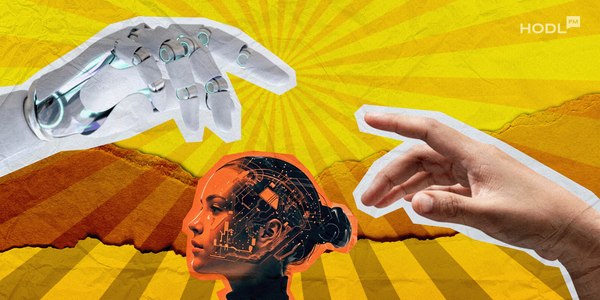Its groundbreaking benefits aside, AI raises concerns, from sci-fi-fueled fears of losing control over AI to worries about job losses to machines, though most of these fears have not materialized. But there is one real looming threat using AI, even at the present: AI fraud.
Fraud using AI is actually a growing concern in the tech world as it allows for sophisticated scams such as deepfakes, synthetic identities, and even account takeovers. As generative AI technology becomes more accessible and affordable, new scammers are finding new ways to exploit it. But there is a possible defense, or rather a protective layer that can prevent all AI fraud if implemented correctly: blockchain.
Now let’s take a look at how these decentralized, shared, immutable ledgers called blockchains can be the only thing standing between us and a cyberpunk dystopia where AI rules.
Read also: Safeguarding Against Unregistered Crypto Services
Is This the Real Life or a Deepfake?
Deepfakes are AI-powered images, videos, or audio that can depict real or non-existent people. Deepfakes are so realistic nowadays that they are one of the most threatening tools in the hands of fraudsters. These AI-generated videos or audio clips can very convincingly replicate real people, making it easy to deceive victims.
Related news: TikTok’s AI Avatars Transform Content Creation and Advertising
In 2024, 49% of businesses worldwide reported incidents of deepfake fraud, with a 20% increase since 2022. In one particularly striking case, an employee at an engineering firm transferred $25 million after being tricked by a deepfake video of her company’s CFO
Okay, but what can blockchain do against hyper-realistic deepfakes? Blockchain can create immutable digital records that can be applied to identity verification systems. For instance, a decentralized digital identity solution can store the biometric data and unique identifiers of individuals. During video calls or remote meetings, this data can be cross-checked against the blockchain ledger to confirm whether the person in the video is who they claim to be.
Additionally, blockchain can log video or audio files with unique hashes and make it possible to verify whether a file has been altered or not. Kind of like turning sensitive recordings into NFTs. Neat.
Synthetic Identity Theft is Not a Joke, Jim
Synthetic identity theft is creating fake personas with a combination of real and fabricated information. With AI tools, fraudsters can easily generate fake identities, which are then used to open fraudulent accounts or access financial services.
Those identities are used for any form of cheating the system, ranging from concealing poor credit history to committing fraud and facilitating illegal activities. In credit repair schemes, criminals create synthetic identities to mask past financial missteps to appear more creditworthy to lenders. Some use these identities to secure employment, housing, or other services without any intent to defraud; they simply want access that would otherwise be denied due to existing personal identifiers.
Blockchain-based decentralized identity (DID) systems can store verified and tamper-proof identity data and make it difficult for synthetic identities to fly under the radar. By integrating DIDs into banking and governmental systems, institutions can confirm whether an individual’s identity exists in the blockchain before granting them access.
And no, this doesn’t mean violating personal information, but merely keeping the record on blockchain for automated authentication of real people.
Not too far away from synthetic identity theft are account takeovers, which means hackers use AI-generated deepfakes or stolen credentials to gain unauthorized access to accounts.
It actually gets worse and worse. Deloitte predicts that generative AI could enable fraud losses to reach $40 billion in the U.S. alone by 2027.
Integrating blockchain with multi-layered authentication can provide more secure access control. Smart contracts on blockchain can be used to enforce transaction approvals only when multiple conditions are met, such as biometric verification or decentralized key signatures.
Smarter Email Frauds Can Fool Anybody
Generative AI has elevated good old traditional phishing and BEC scams to new heights. Attackers are now using AI to generate more convincing fake emails, messages, and even chatbots. According to the same report from Deloitte, AI-enabled email fraud could result in up to $11.5 billion in losses by 2027.
Companies have seen a dramatic rise in phishing scams that employ sophisticated language and context-generation tools to deceive even seasoned professionals. Blockchain can help combat these scams by storing email metadata and sender information on a distributed ledger. If an email’s origin can be traced back to a verified and immutable record on the blockchain, it becomes easier to distinguish between legitimate and fraudulent messages.
This system can also be extended to include smart contracts that flag and quarantine suspicious emails before they reach a recipient’s inbox.
Blockchain as a Safety Net
Blockchain can ensure any type of data remains unalterable and transparent, enabling easier verification processes. The transparency that automatically comes with it can be the difference maker in a world where the fake and the real is merged together.
The true potential of both blockchain and AI technologies can be unlocked once their complementary strengths are realized. Blockchain's inherent immutability and AI's sophisticated pattern recognition capabilities make it a dream pair.

Disclaimer: All materials on this site are for informational purposes only. None of the material should be interpreted as investment advice. Please note that despite the nature of much of the material created and hosted on this website, HODL FM is not a financial reference resource and the opinions of authors and other contributors are their own and should not be taken as financial advice. If you require advice of this sort, HODL FM strongly recommends contacting a qualified industry professional.




